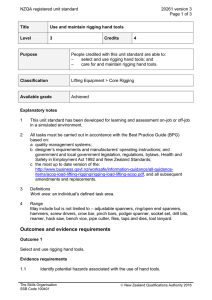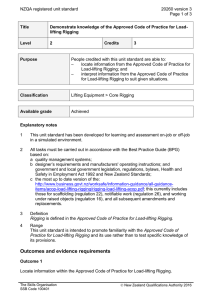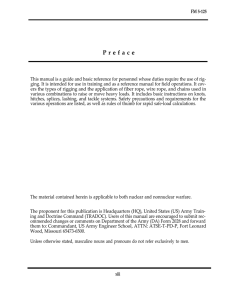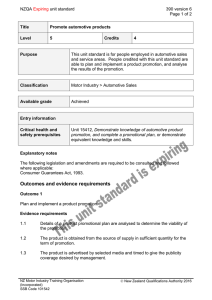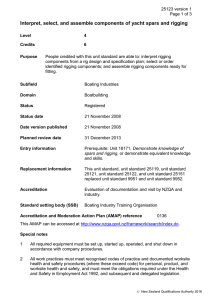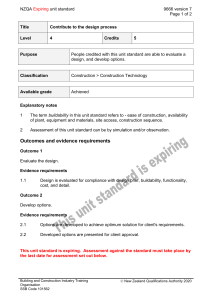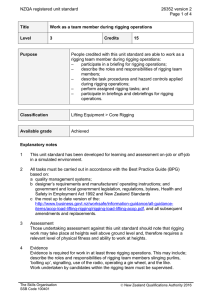NZQA registered unit standard 20263 version 3 Page 1 of 3
advertisement
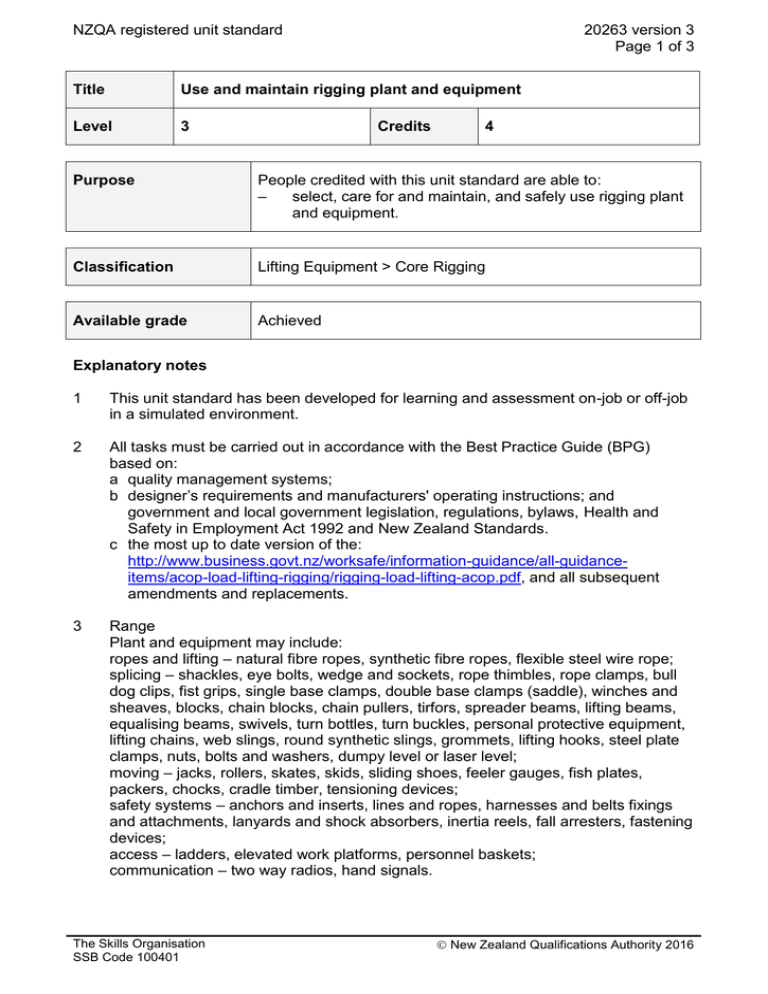
NZQA registered unit standard 20263 version 3 Page 1 of 3 Title Use and maintain rigging plant and equipment Level 3 Credits 4 Purpose People credited with this unit standard are able to: – select, care for and maintain, and safely use rigging plant and equipment. Classification Lifting Equipment > Core Rigging Available grade Achieved Explanatory notes 1 This unit standard has been developed for learning and assessment on-job or off-job in a simulated environment. 2 All tasks must be carried out in accordance with the Best Practice Guide (BPG) based on: a quality management systems; b designer’s requirements and manufacturers' operating instructions; and government and local government legislation, regulations, bylaws, Health and Safety in Employment Act 1992 and New Zealand Standards. c the most up to date version of the: http://www.business.govt.nz/worksafe/information-guidance/all-guidanceitems/acop-load-lifting-rigging/rigging-load-lifting-acop.pdf, and all subsequent amendments and replacements. 3 Range Plant and equipment may include: ropes and lifting – natural fibre ropes, synthetic fibre ropes, flexible steel wire rope; splicing – shackles, eye bolts, wedge and sockets, rope thimbles, rope clamps, bull dog clips, fist grips, single base clamps, double base clamps (saddle), winches and sheaves, blocks, chain blocks, chain pullers, tirfors, spreader beams, lifting beams, equalising beams, swivels, turn bottles, turn buckles, personal protective equipment, lifting chains, web slings, round synthetic slings, grommets, lifting hooks, steel plate clamps, nuts, bolts and washers, dumpy level or laser level; moving – jacks, rollers, skates, skids, sliding shoes, feeler gauges, fish plates, packers, chocks, cradle timber, tensioning devices; safety systems – anchors and inserts, lines and ropes, harnesses and belts fixings and attachments, lanyards and shock absorbers, inertia reels, fall arresters, fastening devices; access – ladders, elevated work platforms, personnel baskets; communication – two way radios, hand signals. The Skills Organisation SSB Code 100401 New Zealand Qualifications Authority 2016 NZQA registered unit standard 20263 version 3 Page 2 of 3 4 Definition Rigging is defined in the Approved Code of Practice for Load-lifting Rigging. 5 Assessment Those undertaking training and assessment against this unit standard should note that rigging work may take place at heights well above ground level and, therefore, requires a relevant level of physical fitness and ability to work at heights. Outcomes and evidence requirements Outcome 1 Select rigging plant and equipment. Evidence requirements 1.1 Select rigging plant and equipment to meet job requirements Outcome 2 Care for and maintain rigging plant and equipment. Evidence requirements 2.1 Clean, service, maintain and store rigging plant and equipment. 2.2 Identify unsafe and/or faulty rigging plant and equipment and dealt with them. Outcome 3 Safely use rigging plant and equipment. Evidence requirements 3.1 Identify potential hazards before starting work. Range hazards may include but are not limited to – electric shock, noise, presence of sharp and/or hot particles, dust, moving parts, cutting tools, compressed air leaks. 3.2 Use rigging plant and equipment recommended by the manufacturer to meet job/task requirements. 3.3 Minimise the risk of electrocution by the use of electrical safeguards. Range 3.4 safeguards may include but are not limited to – residual current devices, isolating transformers, monitored earth circuits, double insulated tools; evidence of three is required. Minimise the risk of fall through safe working practices and complying to work plans. The Skills Organisation SSB Code 100401 New Zealand Qualifications Authority 2016 NZQA registered unit standard may include but is not limited to – scissor lifts, cherry pickers, fall protection systems, inertia reels, static lines. Range 3.5 20263 version 3 Page 3 of 3 Eliminate, isolate, and/or minimise hazards for safe work practice. safe work practice includes but is not limited to – the use of personal protective equipment, following worksite and company health and safety procedures and manufacturer’s specifications. Range Planned review date 31 December 2019 Status information and last date for assessment for superseded versions Process Version Date Last Date for Assessment Registration 1 23 November 2003 31 December 2016 Review 2 23 March 2006 31 December 2016 Review 3 16 July 2015 N/A Consent and Moderation Requirements (CMR) reference 0003 This CMR can be accessed at http://www.nzqa.govt.nz/framework/search/index.do. Please note Providers must be granted consent to assess against standards (accredited) by NZQA, before they can report credits from assessment against unit standards or deliver courses of study leading to that assessment. Industry Training Organisations must be granted consent to assess against standards by NZQA before they can register credits from assessment against unit standards. Providers and Industry Training Organisations, which have been granted consent and which are assessing against unit standards must engage with the moderation system that applies to those standards. Requirements for consent to assess and an outline of the moderation system that applies to this standard are outlined in the Consent and Moderation Requirements (CMRs). The CMR also includes useful information about special requirements for organisations wishing to develop education and training programmes, such as minimum qualifications for tutors and assessors, and special resource requirements. Comments on this unit standard Please contact The Skills Organisation at reviewcomments@skills.org.nz if you wish to suggest changes to the content of this unit standard. The Skills Organisation SSB Code 100401 New Zealand Qualifications Authority 2016
